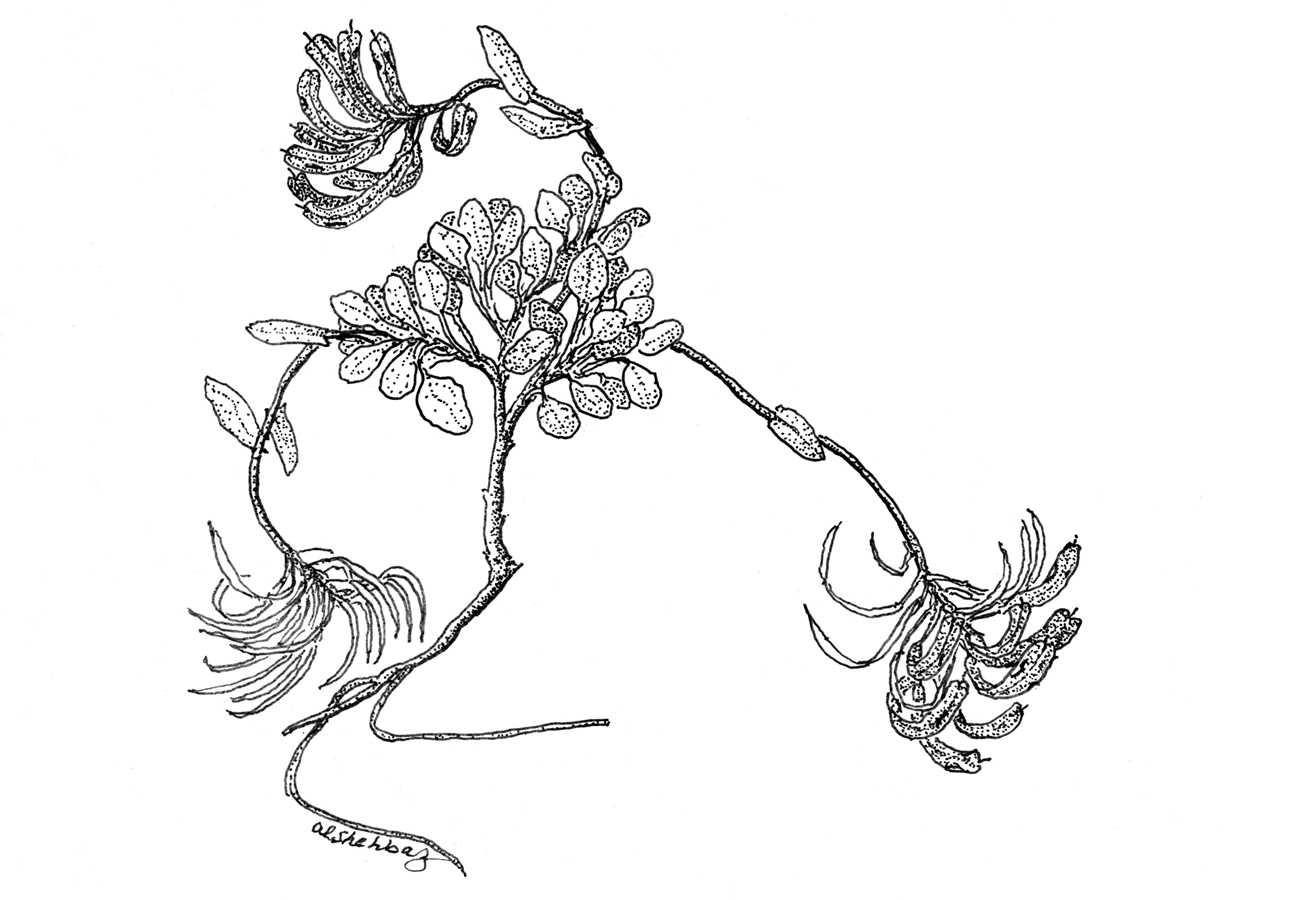Abstract
Noccaea Moench (1802: 89) is a large genus the vast majority of its species were originally described in Thlaspi Linnaeus (1753: 645). Meyer (1973) divided the latter genus into 12 segregates, including Noccaea, to which he placed 67 Eurasian and NW African species in four sections (Meyer: 2006). Experts on the Brassicaceae differ in the delimitation of Noccaea and some (e.g., Al-Shehbaz: 2014; Firat et al.: 2014; Güzel et al.: 2018; Özgişi et al.: 2018a, 2018b; Özüdoğru: 2018; Özüdoğru et al.: 2019; Özgişi: 2020a, 2020b) broadly delimit the genus to include most of Meyer’s dozen segregates and accept some 136 species, including the more recent novelties and nomenclatural adjustments by Bartolucii, Galasso & Peruzzi in Peruzzi et al. (2015), German (2016: 2017, 2018), Güzel et al. (2018), Özgişi et al. (2018b), and Özüdoğru et al. (2019). By contrast, a narrower generic concept for Noccaea was recognized in BrassiBase (https://brassibase.cos.uni-heidelberg.de/), Ali et al. (2016), and Karaismailoğlu & Erol (2018). As currently delimited, all except six species of Noccaea are Eurasian. Two species are endemic to the United States and one each in Algeria, Mexico, Patagonian South America, and Arctic Canada and Alaska (Al-Shehbaz: 2014).
References
<p> https://doi.org/10.12705/651.6</p>
<p>Al-Shehbaz, I.A. (2002) <em>Noccaea nepalensis, </em>a new species from Nepal, and four new combinations in <em>Noccaea</em> (Brassicaceae). <em>Adansonia</em> 24: 89–91.</p>
<p>Al-Shehbaz, I.A. (2014) A synopsis of the genus <em>Noccaea</em> (Coluteocarpeae, Brassicaceae). <em>Harvard Papers in Botany</em> 19 (1): 25–51.</p>
<p> https://doi.org/10.3100/hpib.v19iss1.2014.n3</p>
<p>Al-Shehbaz, I.A. (2015) Brassicaceae. <em>In:</em> Hong, D.Y. (ed.) <em>Flora of Pan-Himalaya</em>, vol. 30. Science Press and Cambridge University Press, 594 pp.</p>
<p>Fırat, M., Özüdoğru, B., Tarıkahya-Hacıoğlu, B., Bülbül, A., Al-Shehbaz, I.A. & Mummenhoff, K. (2014) Phylogenetic position and taxonomic assignment of <em>Thlaspi aghricum</em> P.H.Davis & K.Tan (Brassicaceae). <em>Phytotaxa</em> 178: 287‒297.</p>
<p> https://doi.org/10.11646/phytotaxa.178.4.2</p>
<p>German, D.A. (2016) Taxonomic notes on miscellaneous Cruciferae. <em>Turczaninowia</em> 19 (4): 129‒135.</p>
<p> https://doi.org/10.14258/turczaninowia.19.4.17</p>
<p>German, D.A. (2017) What is <em>Cochlearia venusta </em>(Cruciferae)? <em>Phytotaxa </em>297: 295–298.</p>
<p> https://doi.org/10.11646/phytotaxa.297.3.12</p>
<p>German, D.A. (2018) On the identity of some endemic SW Asian Cruciferae. I. <em>Thlaspi</em> s.l. <em>Turczaninowia</em> 21 (1): 180–187.</p>
<p> https://doi.org/10.14258/turczaninowia.21.1.18</p>
<p>Güzel, Y, Özüdoğru, B, Kayikci, S, Özgişi, K (2018) <em>Noccaea ali-atahanii</em> (Brassicaceae): A new species from southern Anatolia. <em>Turkish Journal of Botany</em> 42: 780–789.</p>
<p> https://doi.org/10.3906/bot-1805-40</p>
<p>Hooker, J.D. & Thomson, T. (1861) Praecursores ad Floram Indicam. <em>Journal of the Proceeding of the Linnaean Society, Botany</em> 5: 128–181.</p>
<p> https://doi.org/10.1111/j.1095-8312.1861.tb01344.x</p>
<p>Karaismailoğlu, M.C. & Erol, O. (2018) Seed structure and its taxonomic implications for genus <em>Thlaspi</em> sensu lato sections <em>Nomisma</em>, <em>Thlaspi</em>, and <em>Pterotropis</em> (Brassicaceae). <em>Turkish Journal of Botany</em> 42 (5): 591–09.</p>
<p> https://doi.org/10.3906/bot-1709-28</p>
<p>Linnaeus, C. (1753) <em>Species plantarum.</em> L. Salvius, Holmiae [Stockholm], 1200 pp.</p>
<p>Meyer, F.K. (1973) Conspectus der “<em>Thlaspi</em>”-Arten Europas, Afrikas und Vorderasiens. <em>Feddes</em> <em>Repertorum</em> 84: 449–470.</p>
<p> https://doi.org/10.1002/fedr.19730840503</p>
<p>Meyer, F.K. (2006) Kritische Revision der “<em>Thlaspi</em>”-Arten Europas, Afrikas un Vorderasiens. Spezieller Teil. IX. <em>Noccaea</em> Moench. <em>Haussknechtia</em> Beiheft 12: 1–341.</p>
<p>Moench, C. (1802) <em>Supplementum ad Methodum Plantas a staminum situ describendi.</em> In Officina Nova Libraria Academiae, Marburgi Cattorum [Marburg], iv + 328 pp.</p>
<p>Özgişi, K. (2020a) A new species of <em>Noccaea</em> (Brassicaceae) from central Anatolia. <em>Phytotaxa</em> 432: 95–103.</p>
<p> https://doi.org/10.11646/phytotaxa.432.1.8</p>
<p>Özgişi, K. (2020b) Structural characterization of ITS2 and CBC species concept applications in the tribe Coluteocarpeae. <em>Turkish Journal of Botany </em>44: 295–308.</p>
<p> https://doi.org/10.3906/bot-1911-4</p>
<p>Özgişi, K., Özüdoğru, B. & Ocak, A. (2018a) Contributions to Turkish flora: taxonomic and distributional notes on the poorly known <em>Noccaea</em> (Brassicaceae) species. <em>Phytotaxa</em> 46: 247–257.</p>
<p> https://doi.org/10.11646/phytotaxa.346.3</p>
<p>Özgişi, K., Ocak, A. & Özüdoğru, B. (2018b) <em>Noccaea birolmutlui</em>, a new crucifer species from south west Anatolia, Turkey. <em>Phytotaxa</em> 345 (1): 59–67.</p>
<p> https://doi.org/10.11646/phytotaxa.345.1.7</p>
<p>Özüdoğru, B. (2018) Phylogenetic position, taxonomy, distribution, and conservation status of the rare and poorly-known <em>Noccaea rosularis</em>, the generic type of <em>Masmenia</em> (Brassicaceae). <em>Phytotaxa</em> 344: 169‒176.</p>
<p> https://doi.org/10.11646/phytotaxa.344.2.5</p>
<p>Özüdoğru, B., Özgiþi, K., Tarıkahya-Hacıoğlu, B., Ocak, A., Mummenhoff, K. & Al-Shehbaz, I.A. (2019) Phylogeny of the genus <em>Noccaea</em> (Brassicaceae) and a critical review of its generic circumscription. <em>Annals of the Missouri Botanical Garden</em> 104: 339‒354.</p>
<p> https://doi.org/10.3417/2019347</p>
<p>Peruzzi, L., Domina, G., Bartolucci, F., Galasso, G., Peccenini, S., Raimondo, F.M., Albano, A., Alessandrini, A., Banfi, E., Barberis, G., Bernardo, L., Bovio, M., Brullo, S., Brundu, G., Brunu, A., Camarda, I., Carta, L., Conti, F., Croce, A., Iamonico, D., Iberite, M., Iiriti, G., Longo, D., Marsili, S., Medagli, P., Pistarino, A., Salmeri, C., Santangelo, A., Scassellati, E., Selvi, F., Soldano, A., Stinca, A., Villani, M., Wagensommer, R.P. & Passalacqua, N.G. (2015) An inventory of the names of vascular plants endemic to Italy, their loci classici and types. <em>Phytotaxa</em> 196: 1–217.</p>
<p> https://doi.org/10.11646/phytotaxa.196.1.1</p>


